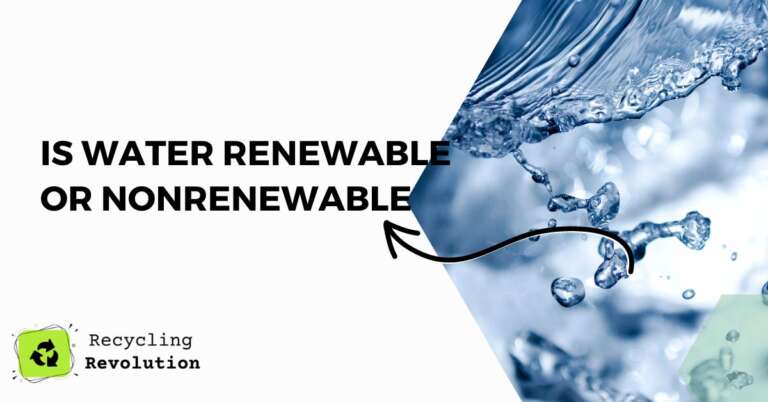Water is life – a statement that rings true for all living creatures. But as we scramble to ensure a future with sustainable resources, the question becomes: is water truly renewable?
tl;dr: Water is both renewable and nonrenewable depending on the context. While the water cycle naturally replenishes our fresh water sources, human activities can lead to depletion faster than nature can replenish. Be wise, conserve water!
Water’s Natural Recycling System: The Water Cycle
Every droplet of water you’ve sipped has possibly been a part of an ancient river or quenched the thirst of a dinosaur. It’s a testament to nature’s magnificent recycling system: The Water Cycle. This process, involving evaporation, condensation, and precipitation, ensures that water is, in theory, a renewable resource.
Water from our lakes, rivers, and oceans evaporates, forms clouds, and falls back to Earth in the form of rain, snow, or sleet. This cycle is continuous, ensuring that the same water has been recycled for millions of years.
Note: This process doesn’t increase or decrease Earth’s total water volume. It merely changes its location and form.
The Human Angle: Over-extraction and Contamination
Enter the human species. Our activities, unfortunately, tip the scales. When we over-extract groundwater faster than it’s replenished, or contaminate freshwater sources, we are, in effect, making water a nonrenewable resource.
I recommend getting into the studies, around 30% of the world’s freshwater is stored underground in the form of groundwater. With increasing global populations and industries, groundwater is extracted at a pace much faster than it can be naturally replenished.
Furthermore, contamination from agriculture, industry, and human settlements often makes this water unfit for consumption or use.
Climate Change: The Unseen Culprit
Another player in this narrative is climate change. It directly impacts the water cycle by altering precipitation patterns, increasing rates of evaporation, and causing more frequent and severe droughts. As global temperatures rise, the demand for water increases while its availability shrinks.
A report from the Intergovernmental Panel on Climate Change (IPCC) stated that for every degree of global warming, approximately 7% of the world’s population will see a decrease of 20% in renewable water resources. This alarming statistic pushes water further into the “nonrenewable” bracket for many regions.
Small Actions, Big Impact: Conserving Our Precious Resource
Now that we understand the tug-of-war between nature’s efforts to renew water and human actions pushing it towards non-renewability, it’s evident we need to swing the balance.
Scientists recommend the following:
- Reduce Wastage: Simple actions, like turning off the tap while brushing or fixing leaky pipes, can save gallons of water.
- Harvest Rainwater: Collecting rainwater for non-drinking purposes can significantly reduce our reliance on groundwater.
- Promote Sustainable Agriculture: Agriculture consumes a large chunk of freshwater. Adopting sustainable farming practices can make a huge difference.
- Stay Educated: Awareness of the situation is half the battle. Ensure you and those around you understand the importance of water conservation.
Note: Every drop counts. Never underestimate the impact of your individual efforts.
Understanding Water Sources: Surface vs. Groundwater
When discussing water’s renewability, it’s vital to differentiate between surface water and groundwater. While both are interconnected, they have different renewal rates and vulnerabilities.
Here is a quick version of the complexities
| Criteria | Surface Water | Groundwater |
|---|---|---|
| Source of Recharge | Precipitation, snowmelt, runoff from land | Infiltration from soil, surface water bodies, rain |
| Recharge Rate | Faster (days to months) | Slower (months to centuries) |
| Vulnerability to Pollution | High (exposed to atmosphere & land) | Low (protected by overlying soil) |
| Response Time to Environmental Changes | Immediate to very short | Longer (changes manifest over extended periods) |
| Sustainability Concerns | Variable (dependent on precipitation) | Steady (but concerns of over-extraction) |
| Storage | Lakes, reservoirs, rivers | Aquifers, water tables |
| Accessibility | Easier (surface access) | Requires drilling and infrastructure |
Surface Water: Rivers, Lakes, and Reservoirs
Surface water is found in bodies like rivers, lakes, and reservoirs. These sources are directly influenced by the water cycle. Rainfall replenishes them, but they’re also susceptible to quick depletion due to evaporation, especially in hotter climates.
I recommend being cautious of human impacts on surface water. Dams, for instance, while beneficial for creating reservoirs and producing hydroelectric power, can disrupt the natural flow of rivers. This can lead to reduced water volumes downstream, affecting both humans and ecosystems reliant on that water.
Groundwater: Hidden But Crucial
Groundwater, stored in underground aquifers, acts as a buffer during periods of drought. These aquifers are recharged by the percolation of rainwater through the soil. But, here’s the catch: some of these aquifers, especially the deeper ones, can take hundreds to thousands of years to recharge fully.
Over-extraction of groundwater, known as groundwater mining, poses a severe threat. Once these deep aquifers are depleted, they can’t just be refilled. They might even collapse, losing their storage capacity forever.
Note: Groundwater extraction has other consequences too. In many coastal regions, over-extraction leads to saltwater intrusion, where seawater replaces the extracted freshwater, making it unsuitable for consumption.
The Quality Question: It’s Not Just About Quantity
It’s a common misconception that water renewability is solely a numbers game. In truth, the quality of water matters just as much, if not more.
Pollution, be it from industrial effluents, agricultural runoff, or improper waste disposal, can render water sources unusable. Even if water exists, if it’s polluted beyond use or poses health risks, its functional availability diminishes.
I recommend a proactive stance on water quality. It’s far more cost-effective and sustainable to prevent water pollution in the first place than to clean it up after the fact.
The Role of Ecosystems in Water Renewability
Ecosystems, particularly wetlands, forests, and grasslands, play a pivotal role in maintaining the water cycle. They act as natural filters, purifying water and ensuring a steady release to both surface and groundwater sources. Destruction of these ecosystems can disrupt the water cycle and decrease the quality of water.
For instance, wetlands absorb excess rainwater, reducing the risk of flooding. They also act as filters, trapping pollutants and sediments. Their degradation can lead to increased flood risks and decreased water quality.
I recommend supporting and participating in initiatives that aim to protect and restore these ecosystems. Their health directly impacts water’s renewability.
Water Consumption and the Global Divide
Globally, there’s an uneven distribution of water consumption. Developed nations, with their industrialized economies and lifestyle patterns, often have higher per capita water footprints than developing nations. However, many arid regions, which are water-scarce, fall within developing nations, leading to a complex interplay of water availability and demand.
Note: It’s a shared responsibility. While individual efforts are crucial, international cooperation and policy-driven actions can make a significant difference in addressing the global water challenge.
Technological Innovations: A Beacon of Hope
In the face of this looming crisis, technology offers a glimmer of hope. Innovations like water-efficient appliances, wastewater recycling systems, and desalination plants (turning seawater into freshwater) are pivotal in addressing both the demand and supply sides of the water equation.
I recommend embracing and advocating for these technologies. While they’re not a replacement for natural water sources, they’re essential tools in our arsenal to combat the challenges posed by water scarcity.
In sum, the question of water’s renewability isn’t black or white. It’s a myriad of grays, intricately woven with nature’s processes and human actions. Our future hinges on recognizing these complexities and acting in harmony with the planet’s rhythms. The water we save today ensures a brighter, more sustainable tomorrow.
Conclusion
So, is water renewable or nonrenewable? The answer is intricate. Nature gifts us with a renewable water system, but human actions and climate change are shifting this balance. For some regions, water is on the brink of becoming nonrenewable. For others, the generous cycles of nature continue to provide.
The responsibility is ours. Only through collective action can we ensure that water remains a renewable resource for future generations.
FAQ
Is the total amount of water on Earth constant?
Yes, the total volume remains constant, but its distribution and usability change due to natural processes and human activities.
What percentage of Earth’s water is freshwater?
About 2.5%. However, a significant portion of this is trapped in ice caps and glaciers.
How can industries play a role in water conservation?
Industries can adopt sustainable water practices, recycle wastewater, and invest in technologies that reduce water usage.
Remember, it’s a shared planet, and the choices we make today determine the legacy we leave behind. Stay curious, stay informed, and most importantly, stay hydrated responsibly!

